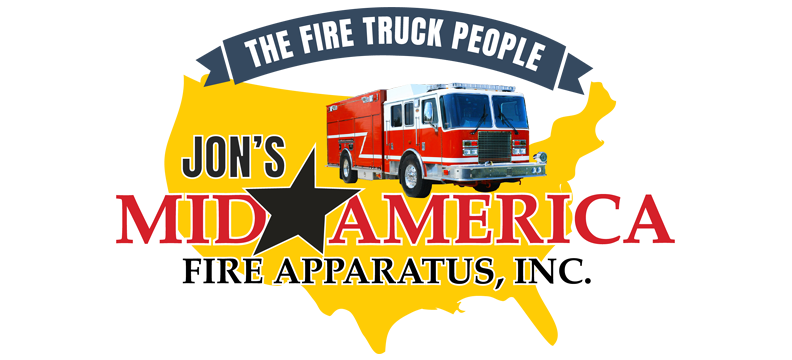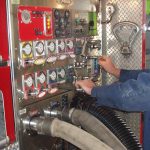As you review your department’s current fleet of apparatus, perhaps as you’re preparing your budget for the upcoming fiscal year, you identify one or more fire trucks that need replacing.
Buying a new apparatus is likely the first option that comes to mind. But did you know there are many advantages to considering a quality used apparatus?
For example, when the South Callaway Fire Protection District in Central Missouri needed to replace a heavy rescue truck, Chief Jeffrey Wallendorf was considering the purchase of a brand new quint. However, the department ended up purchasing two used quints for less than what the single new model would have cost.
There are two primary factors at play when purchasing apparatus and other equipment:
- Satisfying budgetary concerns and getting approval from decision makers
- Meeting the safety needs of your community
Let’s talk about how a used fire truck may help you fit the bill on both criteria.
Related Post: How to Find a Fire Truck that Matches Your Department’s Needs
Use Your Funds More Wisely
As a fire department, you must constantly be mindful of making the best possible use of taxpayer money.
You have to win the approval of local officials to get your fair share of public funds, or you may derive funding from property or other taxes. Regardless of how your budget is determined, you have limited financial resources to work with.
You also have to justify the share of your budget allocated to apparatus, equipment, personnel, and other expenses.
This means doing careful due diligence on all purchases. You need to keep detailed records on budgets, deployments, and service demands to inform your use of funds for purchasing apparatus, as well as the decision of whether to select a new or used fire truck.
To put things into perspective, consider that a new apparatus can cost as much as $1 million or more. But South Callaway, from our earlier example, was able to purchase two used quints for $600,000, and the department had money left over to pay for a few upgrades so the trucks would be ready to serve the community’s needs.
Optimize Your Fleet for the Needs of Your Community
How large is your department’s service area? How many stations do you have? How many firefighters do you have? These are important questions to ask when contemplating the purchase of apparatus.
For example, the South Callaway Fire Protection District serves a 175 square-mile area with five stations located throughout the district. The district includes schools, a nuclear power plant, large farming operations, and residential neighborhoods of all sizes.
#1: What is Your Annual Run Volume?
According to the National Fire Protection Association, fire departments responded to 192.6% more calls in 2013 than in 1980, but 58.7% fewer of those calls were classified as fires.
| 1980 | 2013 | |
|---|---|---|
| Emergency calls to fire departments | 10.8 million | 31.6 million (+192.6% ) |
| Emergency calls classified as fires | 3 million | 1.24 million (-58.7%) |
| % of Emergency calls classified as fires | 27.8% | 3.9% |
Source: NFPA.
Of course every community is different, so your district may be seeing call patterns than deviate from what is reflected in the national data.
Your run volume affects the wear and tear on your fleet, which impacts maintenance needs and apparatus lifespan. This, of course, will affect your frequency of purchasing replacement trucks. Given the high cost of new apparatus, a quality used fire truck may ease the budgetary strain associated with more frequent purchases to address both overall call volume and the diversification in the types of calls you get.
#2: What Kinds of Emergencies Are You Responding To?
The vast majority of calls to fire departments are for medical emergencies such as cardiac arrest, along with injuries such as those from auto accidents. And although the rate of fires has declined, they do still occur.
You must consider the types of emergencies most often occurring in your community when allocating resources to apparatus needs. Whether your department opts for specialized trucks for specific types of incidents, or multi-purpose vehicles that can accommodate a wide range of emergencies, this may be where purchasing used apparatus can really help with cost savings.
Ask yourself the following questions when planning your purchase:
- Of the calls your department responds to, what percent are actual structural fires?
- How many are outdoor fires?
- How many do not involve fires at all?
- How many are medical emergencies such as cardiac arrest?
- How many are accidents involving property damage and injuries, such as a car wreck?
- How many involve hazardous substances or electrical dangers?
#3: Is Your Fleet Optimized for the Number and Type of Calls You Handle?
Understanding the volume and type of calls your department receives will determine the apparatus you need and what kind of equipment it must accommodate. That includes pumps, tanks, aerial ladders, breathing apparatus, and more.
Often a department will arrive on the scene with the same type of equipment regardless of the type of emergency, when it may be a better use of resources to tailor your fleet to specific types of emergencies, including those that don’t involve fires.
The need for more versatile response capabilities could easily translate into higher apparatus and equipment costs — whether your department opts for a larger fleet of highly specialized apparatus, or a smaller fleet of multipurpose fire trucks.
After assessing the needs of his district, for example, South Callaway’s Wallendorf determined that his department needed a versatile apparatus that could accomplish a multitude of different tasks.
This need to accommodate a more diverse array of emergencies is another area where a quality used fire truck could help get the specs you need for less money than you would spend on a new apparatus.
Related Post: Does Your Department Need a Custom Fire Apparatus?
#4: Have you addressed other key concerns?
Besides the need to consider the size and location of your district, and the volume and type of calls you receive, there are four other considerations that will impact what kind of apparatus you need to purchase — and whether used or new would make the most sense.
- Water flow needs. According to South Callaway’s Wallendorf, his fire district needed additional water flow in certain portions of its geographic coverage area. The abundance of hydrants in close proximity to most buildings and how close you are to the site of a call will impact this decision.
- Refurbishment needs. You need to weigh the cost of purchasing a new model that already has everything you need versus buying a cheaper used model and adding upgrades.
- Maintenance. Resources invested in a quality maintenance program will extend the life of your used apparatus and save you money on the initial purchase costs.
- Technology needs. The newer technology found in brand new apparatus should be included if it’s required by local law or essential to the types of calls your department responds to. However, going for the latest bells and whistles, if they aren’t required, will add unnecessary costs and training time, and will compromise user-friendliness for firefighters. If you find a quality used apparatus that has everything you need to meet the needs of your district, you really don’t need to spend more just to get the latest gadget if it doesn’t add anything of value.
If you’re in the process of purchasing apparatus, and you’re wondering whether a used fire truck would be the right move, we’re here to help you out at Jon’s Mid America. Give us a call anytime at 877-562-8785. We look forward to answering your questions and helping you purchase the right apparatus to meet the needs of your community.


